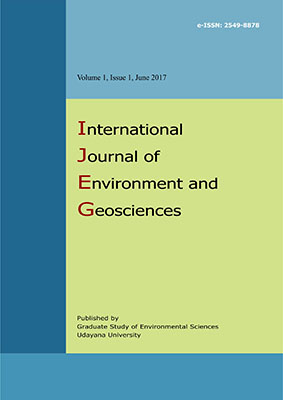Remote Sensing Application to Estimate Groundwater Recharge in Denpasar and Surrounding Areas
Abstract
Water is one of the most important resources for human life, both to support the daily activities and for irrigation purposes as well as supporting tourism industry. Until now the groundwater is still ranked as the major needs, especially in densely populated areas like Denpasar. Groundwater is renewable natural resources, and plays an important role in the provision of water supplies for various purposes. Understanding the spatial variability of groundwater recharge is very important for proper water resource management. Precipitation measurement by satellite especially Global Satellite Mapping for Precipitation, can be applied to large areas only, it can be stated that use of satellite data always results in an improvement of the spatial precipitation estimate if gauge density is low. The aim of this research was to determine precipitation patterns, precipitation groundwater relationship and to estimate local groundwater recharge rate across the Southern Bali basin using remote sensing. This study considers the direct estimation of recharge using recovery of the groundwater level (?H) and total precipitation (Pt) during the wet period. Groundwater recharge was estimated from these two variables using a simple regression equation. The patterns of precipitation in research area was monsoonal dry season occurred in July to August, wet season occurs during November to April and punctuated by transitional season. Precipitation influence on groundwater oscillation occurred on 1~2 months earlier. The amount of recharge rate in the study area based on the results of the study period 2005~2009, for the precipitation data from Global Satellite Mapping for Precipitation ranges from 218 ~ 220 mm per year or about 26 percent of the annual average of precipitation and 650 ~ 660 mm per year or about 32 percent based on the rain gauge data.Downloads
Download data is not yet available.
Published
2017-02-04
How to Cite
ARTABUDI, I Nyoman; OSAWA, Takahiro; SUYASA, I Wayan Budiarsa.
Remote Sensing Application to Estimate Groundwater Recharge in Denpasar and Surrounding Areas.
International Journal of Environment and Geosciences, [S.l.], v. 1, n. 1, feb. 2017.
ISSN 2549-8878.
Available at: <https://ojs.unud.ac.id/index.php/ijeg/article/view/28828>. Date accessed: 08 jan. 2026.
doi: https://doi.org/10.24843/ijeg.2017.v01.i01.p02.
Issue
Section
Articles
Keywords
precipitation; groundwater; satellite; recharge
Authors who publish with this journal agree to the following terms:
- All articles published by International Journal of Environment and Geosciences (IJEG) and Graduate Study of Environmental Sciences, Udayana University are made available under an open access license worldwide immediately. This means everyone has free and unlimited access to the full-text of all articles published in International Journal of Environment and Geosciences (IJEG), and everyone is free to re-use the published material given proper accreditation/citation of the original publication. Open access publication is supported by authors' institutes or research funding agency by payment of a comparatively article processing charge for accepted articles (See Author Fees). International Journal of Environment and Geosciences (IJEG) and Graduate Study of Environmental Sciences, Udayana University publish articles under the Creative Commons Attribution License.
- Authors are able to enter into separate, additional contractual arrangements for the non-exclusive distribution of the journal's published version of the work (e.g., post it to an institutional repository or publish it in a book), with an acknowledgement of its initial publication in this journal.
- Authors are permitted and encouraged to post their work online (e.g., in institutional repositories or on their website) prior to and during the submission process, as it can lead to productive exchanges, as well as earlier and greater citation of published work (See The Effect of Open Access).





